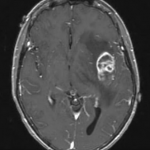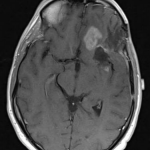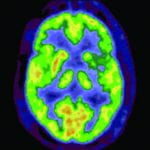More information about conditions treated by the MRI-guided laser interstitial therapy is below.
Adult and pediatric cases
 | Inoperable tumors that are newly diagnosed or after treatment (biopsy, radiation, and/or chemotherapy).
These are tumors that are often not resected through standard open surgical techniques due to the risk of significant injury or morbidity with their removal. Examples of these types of tumors include thalamic glioblastoma and insular gliomas. |
 |
Recurrent tumors (high grade primary brain tumors and metastases). Malignant brain tumors often return after initial treatment with surgery or radiation. If these lesions are approximately 3 centimeters in size, they can often be treated by laser ablation. |
 | Recurrent metastatic tumors after stereotactic radiation (e.g. Gamma Knife or Cyber Knife therapy).
When metastases return after treatment with radiation they are often resistant to further radiation. Additionally, patients may be too frail to undergo standard open surgical approaches. Minimally invasive laser ablation may be an alternative. |
 | Radiation necrosis (after radiation such as Gamma Knife therapy or whole brain radiotherapy).
Radiation necrosis is a situation when parts of the brain have an inflammatory response to the radiation treatment that causes swelling in the brain. This situation may be treated by laser ablation. |
 | Certain forms of epilepsy (e.g. amygdalohippocampectomy candidates).
Certain types of epilepsy that come from a specific region in the brain can be treated with laser ablation. Examples include mesial temporal epilepsy and seizures coming from the insula. For more information, visit Barnes-Jewish Hospital and Washington University’s Epilepsy Center. |